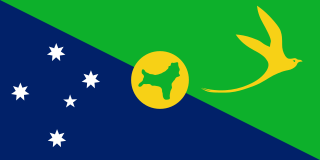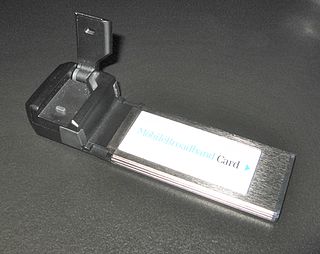Related Research Articles

The Territory of Christmas Island is an Australian external territory in the Indian Ocean comprising the island of the same name. It is located approximately 350 kilometres south of Java and Sumatra and about 1,550 km (840 nmi) north-west of the closest point on the Australian mainland. It has an area of 135 square kilometres (52 sq mi). The territory derives its name from its discovery on Christmas Day 1643 by Captain William Mynors.

The Cocos (Keeling) Islands, officially the Territory of Cocos (Keeling) Islands, are an Australian external territory in the Indian Ocean, comprising a small archipelago approximately midway between Australia and Sri Lanka and relatively close to the Indonesian island of Sumatra. The territory's dual name reflects that the islands have historically been known as either the Cocos Islands or the Keeling Islands.

The telecommunication infrastructure of Singapore spans the entire city-state. Its development level is high, with close accessibility to the infrastructure from nearly all inhabited parts of the island and for all of the population, with exceptions. Today, the country is considered an international telecommunications hub, an achievement that was driven by Singapore's view that high-quality telecommunications is one of the critical factors that support its economic growth.

Telstra Group Limited is an Australian telecommunications company that builds and operates telecommunications networks and markets related products and services. It is a member of the S&P/ASX 20 and Australia's largest telecommunications company by market share.

Telecommunications in Australia refers to communication in Australia through electronic means, using devices such as telephone, television, radio or computer, and services such as the telephony and broadband networks. Telecommunications have always been important in Australia given the "tyranny of distance" with a dispersed population. Governments have driven telecommunication development and have a key role in its regulation.

StarHub Limited, commonly known as StarHub, is a Singaporean multinational telecommunications conglomerate and one of the major telcos operating in the country. Founded in 1998, it is listed on the Singapore Exchange (SGX).
An open-access network (OAN) refers to a horizontally layered network architecture in telecommunications, and the business model that separates the physical access to the network from the delivery of services. In an OAN, the owner or manager of the network does not supply services for the network; these services must be supplied by separate retail service providers. There are two different open-access network models: the two- and three-layer models.

Alvarion Technologies Ltd. is a global provider of autonomous Wi-Fi networks designed with self-organizing capabilities for carrier-grade Wi-Fi, enterprise connectivity, smart city planning, smart hospitality, connected campuses, and connected events.

Mobile broadband is the marketing term for wireless Internet access via mobile (cell) networks. Access to the network can be made through a portable modem, wireless modem, or a tablet/smartphone or other mobile device. The first wireless Internet access became available in 1991 as part of the second generation (2G) of mobile phone technology. Higher speeds became available in 2001 and 2006 as part of the third (3G) and fourth (4G) generations. In 2011, 90% of the world's population lived in areas with 2G coverage, while 45% lived in areas with 2G and 3G coverage. Mobile broadband uses the spectrum of 225 MHz to 3700 MHz.

The Internet in South Africa, one of the most technologically resourced countries on the African continent, is expanding. The internet country code top-level domain (ccTLD) .za is managed and regulated by the .za Domain Name Authority (.ZADNA) and was granted to South Africa by the Internet Corporation for Assigned Names and Numbers (ICANN) in 1990. Over 60% of Internet traffic generated on the African continent originates from South Africa. As of 2020, 41.5 million people were Internet users.
Internet in Australia first became available on a permanent basis to universities in Australia in May 1989, via AARNet. Pegasus Networks was Australia's first public Internet provider in June 1989. The first commercial dial-up Internet Service Provider (ISP) appeared in capital cities soon after, and by the mid-1990s, almost the entire country had a range of choices of dial-up ISPs. Today, Internet access is available through a range of technologies, i.e. hybrid fibre coaxial cable, digital subscriber line (DSL), Integrated Services Digital Network (ISDN) and satellite Internet. In July 2009, the federal government, in partnership with the industrial sector, began rolling out a nationwide fibre-to-the-premises (FTTP) and improved fixed wireless and satellite access through the National Broadband Network. Subsequently, the roll out was downgraded to a Multi-Technology Mix on the promise of it being less expensive and with earlier completion. In October 2020, the federal government announced an upgrade by 2023 of NBN fibre-to-the-node (FTTN) services to FTTP for 2 million households, at a cost of A$3.5 billion.
Internet access is widely available in New Zealand, with 94% of New Zealanders having access to the internet as of January 2021. It first became accessible to university students in the country in 1989. As of June 2018, there are 1,867,000 broadband connections, of which 1,524,000 are residential and 361,000 are business or government.
In Singapore, there are 11,512,900 broadband Internet subscribers. There are three major Internet service providers in Singapore, namely, Singtel, StarHub, and M1 and other growing providers like MyRepublic and ViewQwest. Over the years, the Singapore Government has been promoting the usage of broadband Internet access, as part of its Intelligent Nation 2015 (iN2015) and Smart Nation initiative.

NBN Co Limited, known as simply nbn, is a state-owned corporation of the Australian Government, tasked to design, build and operate Australia's National Broadband Network (NBN) as the nation's wholesale broadband provider. The corporation reports to two shareholder ministers: the Minister for Finance and the Minister for Communications.

The National Broadband Network (NBN) is an Australian national wholesale open-access data network. It includes wired and radio communication components rolled out and operated by NBN Co, a government-owned corporation. Internet service providers, known under NBN as retail service providers or RSPs, contract with NBN to access the data network and sell fixed Internet access to end users.
MyRepublic Group Limited is a Singaporean communications service provider. Launched in 2011, MyRepublic currently operates in Singapore and licenses its platform to operators in Brunei and Indonesia.
Activ8me is the trading name of an Australian telecommunications carrier and Internet service provider (ISP) operated by Australian Private Networks Pty. Ltd. Activ8me specialise in regional and remote Australian telecommunications and are the largest provider of satellite broadband services in Australia.

Vodafone Australia is an Australian telecommunications brand providing mobile and fixed broadband services. Vodafone’s mobile network covers more than 23 million Australians, and Vodafone has commenced the rollout of its 5G mobile network. Vodafone NBN fixed broadband services are available in capital cities and selected regional centres. Vodafone is the third-largest wireless carrier in Australia, with 5.8 million subscribers as of 2020.
Tejas Networks is an optical, broadband and data networking products company based in India. The company designs develops and sells its products to telecom service providers, internet service providers, utilities, security and government entities in 75 countries. The company has built many IPs in multiple areas of telecom networking and has emerged as an exporter to other developing countries including Southeast Asia and Africa.
References
- ↑ "2016 Census QuickStats: Christmas Island". Australian Bureau of Statistics . Archived from the original on 26 August 2017. Retrieved 31 May 2018.
- ↑ Moulton, Emily (28 February 2017). "Christmas Island internet services cut". PerthNow. Retrieved 31 May 2018.
- ↑ "Christmas Island Internet Services". Department of Infrastructure, Regional Development and Cities. 28 February 2017. Retrieved 31 May 2018.
- ↑ "Speedcast Returns Internet Services to Christmas Island". SpeedCast. 14 March 2017. Retrieved 31 May 2018.
- ↑ "Internet access returned to Christmas Island". Minister for Infrastructure, Transport and Regional Development . 10 May 2017. Retrieved 31 May 2018.